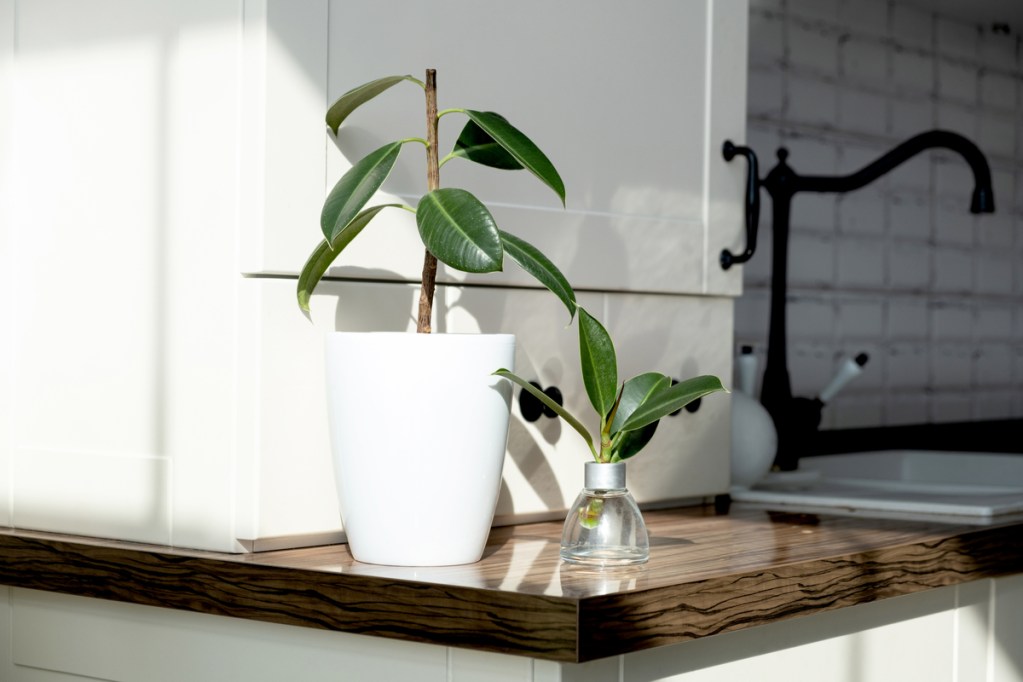The rubber tree plant, or ficus elastica, is one of the sleekest varieties of common houseplants. An elegant addition to any collection, it features leathery lance-shaped leaves that come in either dark green or creamy (and often colorful) patterned leaves emerging from a central stem. Not only is the rubber tree plant stunning, but it’s also easy to maintain. This popular houseplant grows well in homes, offices, and more. If you’re interested in bringing one of these lovely plants home with you, here’s what you need to know! We’ll cover everything from the best soil for rubber plants to how to propagate them.
Where to keep your rubber tree plant

Native to Southeast Asia, ficus elastica is commonly an indoor houseplant, but you can keep it outside. It’s hardy to climate zones 10 and 11, so it’s best to bring it indoors during the winter if you live in colder regions. If you keep your plant outside, leave it in a shady spot or somewhere with dappled indirect bright light. The same goes for indoor plants—you’ll want to keep your plant where it receives bright indirect light.
General rubber tree plant care

While the rubber tree plant is relatively easy to care for, there are a few tips and tricks that you can keep in mind to help your plant thrive.
- Light: The rubber plant can survive low-light situations, although it will do best in bright indirect light. If you have a variegated plant, it appreciates having access to as much light as possible. Sun stressing colorful types, such as the ruby, will help deepen foliage color. That said, you may get burnt tips if you give your plant too much direct bright light.
- Soil: As rubber tree plants do not like wet feet, a well-draining soil is ideal for them. An equal combination of indoor potting mix, cactus soil, and perlite can work well for the rubber plant. For extra drainage, throw in bark or coarse sand.
- Water: The best time to water a rubber plant is when the top inch or two of the soil dries out. The rubber plant is drought tolerant, although you may experience wilting and dropping leaves if you leave it dry for too long. In the winter, water your plant about half as much as you normally would because this is when it goes dormant. A sign that you might be overwatering your ficus elastica is if its leaves start to yellow and drop—the rubber plant will especially be vulnerable to root rot in the winter.
- Temperature: Rubber plants appreciate warmth and do best at room temperature. They dislike drafts, so make sure to keep them away from AC units and heaters to keep their leaves from dropping.
- Fertilizer: An all-purpose liquid fertilizer or any type of balanced fertilizer will suffice for rubber plants throughout the growing season.
- Pests: Rubber tree plants aren’t prone to pests, but they may occasionally experience aphids or scale insects that feed on the plant’s sweet nectar. In this case, you can treat your foliage with neem oil or insecticidal soap.
- Leaf maintenance: With rubber plants, you’ll occasionally want to wipe your leaves with a wet towel so that they retain their glossy shine and photosynthesize properly. Pruning the leaves is another way you can care for your plant—it’ll shoot out more growth for a bushier look.
Propagating rubber plants

Cuttings
Propagating a rubber plant is extremely easy, and it’s a great way to get your plant to grow out even fuller. All you have to do is take a cutting with a clean knife or pair of scissors. Make sure that the part you take has at least three sets of leaves so that you can twist off the lower leaves to expose the nodes. When you cut the stem and expose the nodes, you may notice a white latex oozing out—this is completely normal, but do keep in mind that it’s toxic and can irritate the skin. Stop the sap from bleeding by pressing a tissue against the cut stem.
You can place your cutting inside either water or soil. Rubber plants can be slow to root, so don’t fret if you don’t see leaves right away. To expedite root growth, you can dip your nodes into a rooting powder.
Air layering
Propagating by air layering is another way to multiply your plant. Start by twisting off a few leaves. Then, take a dull knife and carefully slice a branch in half for about four inches. Spread rooting hormone in the cut and wedge some moistened moss in between the sliced branch. You’ll then want to wrap more moss around the branch and exposed nodes, tying everything together with saran wrap.
How fast do rubber tree plants grow?

Rubber tree plants have a fairly quick rate. Under the proper conditions, it can grow up to 2 feet per year. In their native environment, rubber tree plants can reach a mature height of 70 to 100 feet tall. In the U.S., even outdoor rubber trees do not reach that height. However, they will grow as tall as they are able to. Outdoor rubber tree plants can grow to 30 feet tall, while indoor rubber trees are more limited by their container size. Indoor rubber trees, when given enough space, can grow to 6 feet tall (or taller, if you have high ceilings!) Indoor rubber trees can be controlled through pruning as well, and there are dwarf varieties that stay smaller if you need a shorter rubber tree.
So that’s the rubber tree plant, demystified. This plant is a gem when it comes to common houseplants—not only is it readily accessible, but it’s also sleek and easy to maintain. With warm temperatures and sparse watering sessions, you’ll have a healthy, beautiful rubber plant that you can easily propagate and share.




